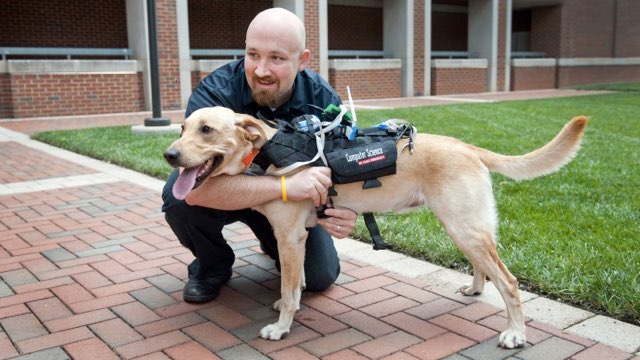Humans speaking to animals is a classic movie trope and a well-worn science fiction concept, but scientists at North Carolina State University are working hard to make it a reality—at least when it comes to man’s best friend. Dr. Alper Bozkurt and Dr. David Roberts, both of whom are associate professors at NC State, Dr. Barbara Sherman, clinical professor of animal behavior at NC State, and their team have developed a platform by which dogs can communicate with their caretakers, and vice versa.
The key to the communication system is a harness that is fitted to the dog and packed with sensors. These sensors monitor movement, temperature and heart rate, which the system can then interpret. A dog’s posture can mean many different things and, when translated, can shrink the gap between human communication and that of dogs. The harness is also equipped with haptic motors that provide tactile feedback to the dog based on commands by the handler, offering two-way computer-enhanced conversations.
A recent paper published by the research team explores using such technologies in search-and-rescue scenarios, where dogs could potentially digitally communicate their findings wirelessly over significant distances to expedite rescue. A system like this could save lives, but computer-aided communication with dogs has a broad range of possible applications.

“This effort represent a significant collaboration among computer scientists, electrical engineers, and veterinary behaviorists,” Dr. David Roberts tells the Daily Dot. “Together with collaborators Dr. Alper Bozkurt and Dr. Barbara Sherman, we’re working to revolutionize the ways in which we communicate with and understand our companions and working partners.”
That revolution may take place in your own backyard. Dr. Roberts says that while the current device is just a proof of concept, the team’s work could well result in a product that any pet owner can buy. “The current prototype is a bit bulky, and has many potential snagging hazards; however, Dr. Bozkurt’s lab has a lot of expertise in miniaturization, and one of our big goals moving forward is to shrink everything significantly to make the harness more comfortable for smaller dogs and reduce the potential for damage due to contact with the environment.”
“I hope the next few years will see a rapid maturation of these types of technologies and that we’ll begin to see commercial products that enrich our relationships with our canine counterparts in a positive and fun way,” Roberts adds.
If you’re like me, at this point you’re thinking “I wonder if cats will ever get a wearable like this,” and the answer is… maybe. I asked Dr. Roberts about a communicator for our feline friends and he brings up a good point. “Cats, being smaller than most dogs, wouldn’t be able to carry as much weight. They also tend to be less tolerant of wearing things like the harness; however, the underlying veterinary, behavioral, and technologies theories still apply.” Roberts adds. “The packaging would definitely have to change though.”
So a kitty harness isn’t entirely out of the question, but for the moment it’s probably best for science to work on conversing with canines rather than attempting to strap something to a house cat. Then again, I think I know exactly what my cat is thinking every time I see him, and it’s always either “feed me” or “go away.”
Photo via NC State University


